| Home > Policy > White Paper, Notice, Announcement > White Paper > JAPAN'S GROWTH AND EDUCATION 1963 > CHAPTER |
||
From about 1893 to 1899 various kinds of secondary and semi-secondary educational institutions including girls high schools, vocational schools and complementary vocational schools were established in addition to middle schools. It was the period between the Sino-Japanese and Russo-Japanese wars and the one in which the Japanese economy entered the developmental stage. The seeds of modern industry shown in the early Meiji Era had grown, cottage industry began to be reorganized into factory industry, as for example, the transition from hand-weaving to mechanical spinning, and the educational function fulfilled by the traditional apprenticeship was now taken over by the new vocational schools. Thus, socio-economic needs began to be reflected in the public educational system.
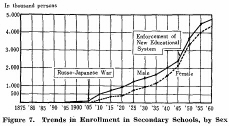
Thus, secondary education, which began to develop since around the time of the Sino-Japanese War (1894~95), experienced a rapid spread when the Japanese economy reached its maturity stage during the period from the end of the Meiji Era to the Showa Era (1926~ ).
It is to be noticed that secondary education in Japan had begun to spread before the Movement for Einheitsschule (uniform school for all) was advocated in Europe after World War I. Also notable is that the remarkable development of secondary education in Japan took place during the period called the 'Taisho Democracy'.
Increase in the income of the people is followed by the increase in the percentage of school attendance and' the spread of better education results in increased production. The amount of the national income per capital of the employed population (covered amount of 1960) and the number of secondary school pupils are shown by decades from 1895 to 1925in Table 4.
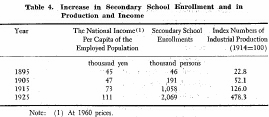
The national income increased only slightly from 1895 to 1905,
but at a much higher rate thereafter. On the other hand the secondary school
enrollment increased greatly through this entire period. Thus, secondary education
was spread far more rapidly than the national income. Secondary education continued
to develop and consolidated the foundation for making lower secondary education
compulsory and for the extension of upper secondary education after World War ![]() .
.
Institutions of Semi-secondary Education
The total enro1lment in institutions of semi-secondary education was abolt 70,000 in 1895, but increased by 18 times by 1925 and by more than 30 times by 1935, as shown in Figure 8.
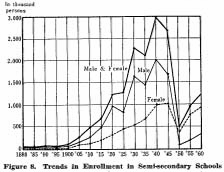
Such increases were mainly due to the spread of youth schools.
After World War ![]() ,
with the reorganization of secondary education under the new educational system,
youth schools were absorbed in secondar7 education and miscellaneous schools
became the only remaining institutions of semi-secondary education. The history
of the development of semi-secondary institutions shows that they declined when
the enrollment in institutions of ordinary secondary education increased rapidly.
,
with the reorganization of secondary education under the new educational system,
youth schools were absorbed in secondar7 education and miscellaneous schools
became the only remaining institutions of semi-secondary education. The history
of the development of semi-secondary institutions shows that they declined when
the enrollment in institutions of ordinary secondary education increased rapidly.
Percentage of Advance to Secondary Education
Generally speaking, secondary education develops on the basis of the spread of elementary education. In Japan even before elementary education achieved 100 per cent enrollment, the percentage of the pupils advancing to secondary education began to increase with accelerated speed.
In 1895 the number of four-year elementary school graduated was only 370,000 persons, out of which about 16,000 children or 4.3 per cent advanced to secondary schools. Among them 13,000 persons went to middle schools, 800 to girls' high schools and 1,600 to normal schools. The percentage of boys advancing was 5.1 per cent while that of girls was 1.3 per cent.
After that, despite the increase in the number of elementary
school graduates, the percentage of advancement increased gradually, reaching
15 per cent in 1920 and exceeding 25 per cent in 1940. After World War ![]() it
leaped to 50 per cent and now it is over 60 per cent. A breakdown by sex shows
that the percentage for boys always exceeded that for girls, but except during
the Meiji Era and around the year of 1950, the difference between the sexes is
minor.
it
leaped to 50 per cent and now it is over 60 per cent. A breakdown by sex shows
that the percentage for boys always exceeded that for girls, but except during
the Meiji Era and around the year of 1950, the difference between the sexes is
minor.
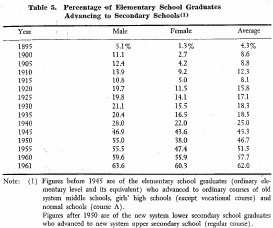
The increase in the percentage of students advancing to secondary education corresponds roughly to the progress in the industrialization of Japan. Let us look into the relations of the two by district. Tokyo and Osaka, when combined, produce about 30 per cent of the total industrial output of the country and are the two major centres of Japanese commerce and industry in the past as well as at the present. The percentage of advancement in the two cities in 1895 was higher than in other districts, being 27.1 per cent in Tokyo and 14.0 in Osaka. In 1960 to percentage for boys was the highest in Tokyo being 79.4, and 71.2 in Osaka.
The reverse was found in Kochi, Miyazaki and Kagoshima Prefectures, where the relatively slow pace of industrialization slowed down the speed of the increase in the percentage of advancement to secondary education. In the case of Kochi Prefecture it increased very slowly from 10.9 per cent in1895 to 15 per cent in 1925 and even decreased to 13 per cent in 1935.The same trend can be observed in Miyazaki and Kagoshima Prefectures. It is interesting to note that these three prefectures experienced decline in the percentage of advancement to secondary education during the economic recession in the early years of the Showa Era (1926~).
Table 6 shows the percentage which secondary school enrollments were of the total population of the corresponding age, during the period from 1895 to 1961.
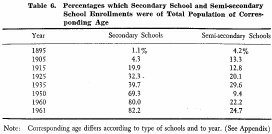
| Back to Top | MEXT HOME |